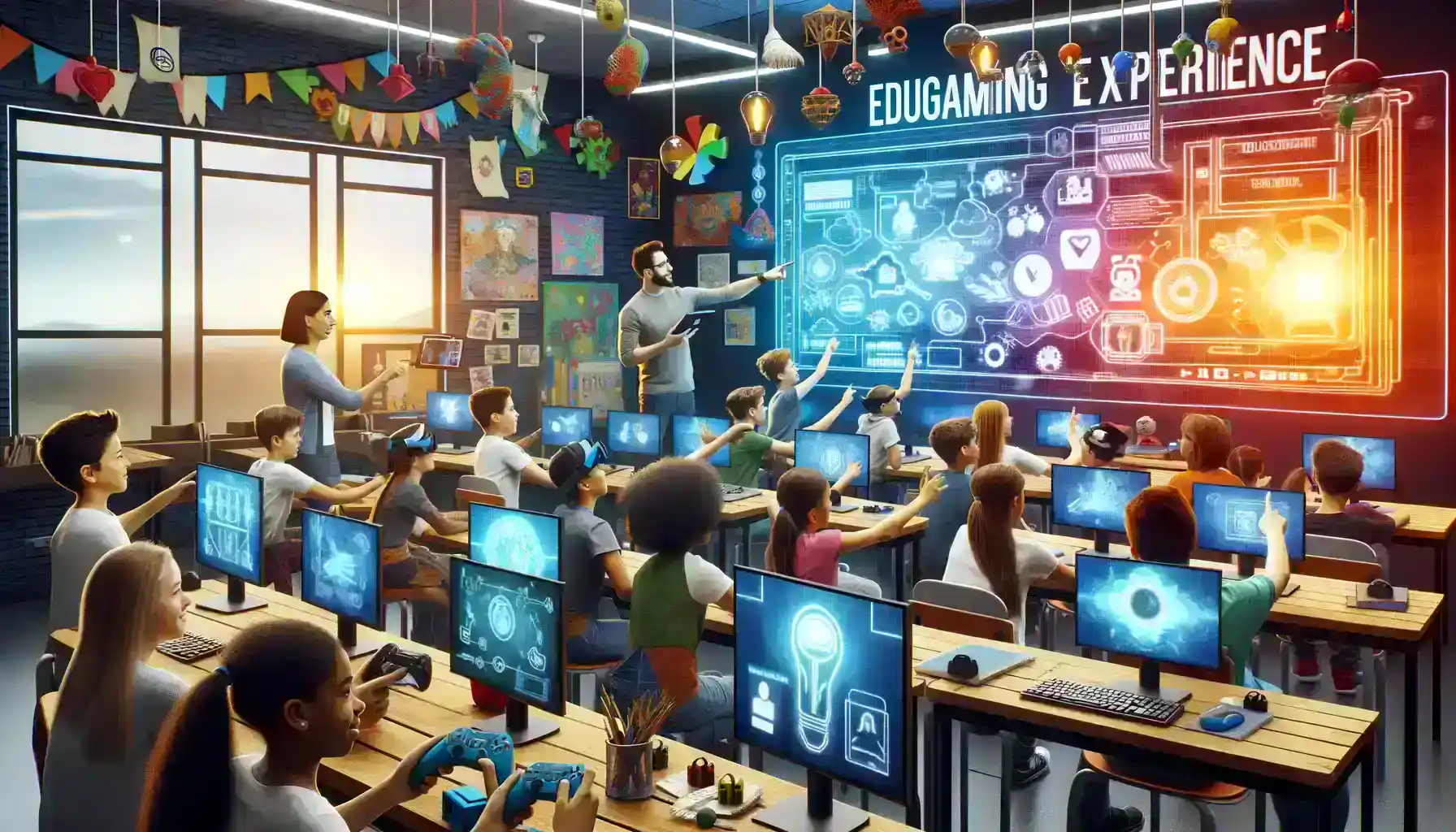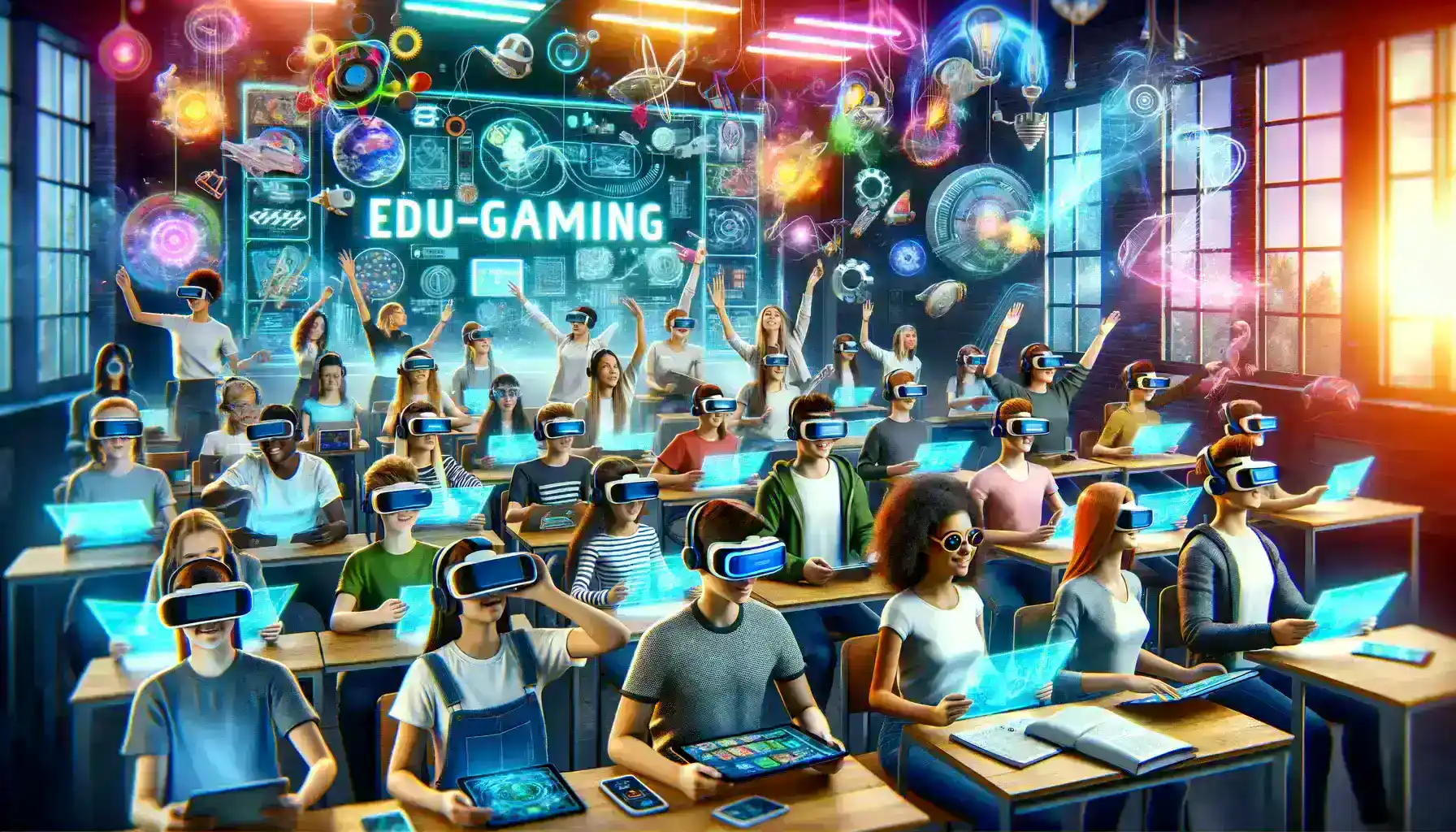Table of Contents
Education is undergoing a revolution, and at the heart of this transformation is the synergy between gamification and artificial intelligence. The EduGaming revolution is reshaping traditional learning paradigms, making education more interactive, immersive, and enjoyable for learners of all ages.
Introduction
In the rapidly evolving landscape of education, the integration of gamification and AI has emerged as a game-changer. This article explores the EduGaming revolution, exploring how the fusion of gaming elements and artificial intelligence is reshaping the educational experience. Through real-time examples, we’ll witness the tangible impact of EduGaming on student engagement, knowledge retention, and the overall learning process.

1. The Power of EduGaming Revolution
Interactive Learning Environments
- Shift from Traditional Classrooms: Traditional classroom settings are evolving into digital environments that encourage active student participation.
- AI-Powered Educational Games: These digital environments incorporate AI-powered educational games that dynamically adapt to the individual learning styles of students.
- Personalized Experience: The integration of AI ensures a personalized learning experience, catering to the unique needs and preferences of each student.
Kahoot:
- Platform Overview: Kahoot! is a widely used interactive learning platform that transforms quizzes into engaging experiences.
- Gamification Elements: The platform employs gamification elements, such as competition, to make learning more enjoyable and interactive.
- AI Algorithm Analysis: Kahoot! utilizes AI algorithms to analyze performance data generated during quizzes.
- Tailored Learning Path: Based on the analysis, the platform tailors future questions, creating a customized learning path for each student.
Enhanced Problem-Solving Skills
- Promotion of Critical Thinking: EduGaming promotes critical thinking and problem-solving by embedding challenges within a game-based context.
- Dynamic Adjustments: AI dynamically adjusts the difficulty of challenges based on a student’s skill level, ensuring a continuous and optimized learning curve.
DragonBox Numbers:
- Game-Based Math Learning: DragonBox Numbers is an example of an educational game that focuses on math learning through a game-based approach.
- AI Adaptation: The game utilizes AI to adapt its math challenges according to the individual progress of each student.
- Deep Understanding: By adjusting dynamically, DragonBox Numbers helps children develop a deep understanding of mathematical concepts.
2. AI’s Role in EduGaming Revolution
Adaptive Learning Paths
Adaptive learning paths involve tailoring educational content to meet the unique needs and abilities of individual learners. Artificial intelligence is employed to analyze user data, providing personalized experiences that cater to each student’s strengths and weaknesses.
How it works:
- AI algorithms process user interactions with educational content in real-time.
- Student performance data, including correct and incorrect answers, time spent on tasks, and learning preferences, is analyzed.
Benefits:
- Students receive a customized learning experience, that addresses their specific academic needs.
- Learners can progress at their own pace, ensuring a solid understanding of foundational concepts before tackling more advanced material.
Knewton: Knewton is an adaptive learning platform used in various educational applications.
- Knewton’s adaptive engine analyzes students’ responses to questions and adjusts subsequent content accordingly.
- The platform continually refines its understanding of each student’s proficiency and learning style, delivering a personalized learning path.
Intelligent Tutoring Systems (ITS): Revolutionizing Learning with AI

Intelligent Tutoring Systems (ITS) leverage artificial intelligence to provide personalized and adaptive learning experiences for students. These systems act as virtual mentors, offering support and guidance tailored to individual needs.
Features:
Personalized Learning: AI analyzes student interactions within educational games to understand strengths and weaknesses and tailors lessons based on individual learning styles and pace.
Adaptive Feedback: Intelligent Tutoring Systems like GeniusTutor evaluate student responses, identify areas of difficulty, and provides targeted feedback and it enables continuous improvement by addressing specific challenges.
Data-Driven Insights: Collects and analyzes data on student performance in real-time and it allows educators to make informed decisions and intervene when necessary.
Cognii for instance is an AI-powered virtual tutor that utilizes natural language processing (NLP) for a sophisticated learning experience:
Assessment Through NLP:
- How it works: Cognii assesses students’ written responses using NLP algorithms.
- Benefit: Provides a nuanced understanding of student comprehension beyond simple multiple-choice answers.
Personalized Feedback:
- How it works: Offers tailored feedback based on the analysis of each student’s unique response.
- Benefit: Guides students with specific insights, addressing misconceptions and reinforcing correct concepts.
Engagement and Interactivity:
- How it works: Engages students in a conversation, making the learning experience more interactive.
- Benefit: Mimics a real tutor-student interaction, enhancing engagement and promoting a deeper understanding of the material.
Continuous Improvement:
- How it works: Tracks progress over time, adapting to the student’s evolving needs.
- Benefit: Supports long-term learning goals by ensuring that the difficulty of tasks aligns with the student’s skill development.
Cognii showcases the transformative potential of AI in education. By combining personalized learning, adaptive feedback, and data-driven insights, these systems enhance the educational experience, providing students with tailored support and fostering a more effective learning journey. As technology continues to advance, the role of ITS in shaping the future of education is poised to become increasingly significant.
3. Realizing the EduGaming Revolution
Increased Motivation and Engagement
Gamification Principles:
- Incorporates elements like rewards, competition, and storytelling.
- Taps into the intrinsic motivation of learners by making the learning process enjoyable and interactive.
Duolingo:
- Gamification Techniques: Duolingo uses a point system, streaks, and virtual rewards to motivate users.
- AI Adaptation: The platform’s AI algorithms analyze user performance and adjust the difficulty of language exercises in real-time.
- Optimal Challenge Level: Ensures that users are consistently challenged at a level that is neither too easy nor too difficult, maintaining engagement.
Measurable Learning Outcomes
Real-Time Analytics:
- AI in EduGaming allows for the tracking and measuring of learning outcomes in real-time.
- Educators can access detailed analytics to understand student progress and identify areas for improvement.
IXL Learning:
- Comprehensive Analytics Dashboard: IXL Learning provides teachers with a detailed analytics dashboard.
- Performance Monitoring: Teachers can monitor student performance, identify strengths, and pinpoint areas that may require additional attention.
- Data-Driven Intervention: Enables data-driven interventions to enhance the overall learning experience.
The above instances showcase how the integration of AI into EduGaming enhances various aspects of the educational experience, from motivation and engagement to personalized learning paths and measurable outcomes. These applications demonstrate the tangible impact of the EduGaming revolution on shaping a more effective and enjoyable educational journey.
4. Challenges and Future Prospects in EduGaming Revolution
Addressing Concerns
Balancing Fun and Learning
- Challenge: Striking the right balance between entertainment and educational content is a delicate task. If the game is too entertaining, it may distract from the educational objectives, while a focus solely on learning may lead to disengagement.
- Prodigy addresses this challenge effectively by blending a captivating fantasy world with math challenges. The game’s storyline motivates students to progress while mastering mathematical concepts.
Accessibility and Inclusivity
- Challenge: Ensuring that EduGaming solutions are accessible to a diverse range of learners, including those with disabilities or limited access to technology, is a significant concern.
- Minecraft: Education Edition incorporates features like the Immersive Reader, providing inclusivity by supporting learners with dyslexia through text-to-speech and other customization options.
Future Trends
Immersive Technologies
- Trend: The integration of augmented reality (AR) and virtual reality (VR) into EduGaming is on the rise, offering a more immersive and interactive learning experience.
- Google Expeditions uses VR to take students on virtual field trips. This immersive approach enhances the learning process by providing a 360-degree view of historical sites, ecosystems, and more.
AI Advancements
- Trend: Future AI advancements will likely bring more sophisticated personalization, adapting content in real-time to cater to individual learning styles and preferences.
- Smart Sparrow utilizes adaptive e-learning technology, powered by AI, to create personalized learning experiences. The platform adjusts the difficulty of tasks based on individual performance, ensuring an optimal learning curve. This highlights the importance of elearning software development in crafting personalized educational experiences that dynamically respond to student needs.
5. Implementing EduGaming in Education: A Practical Guide
Importance of Educator Training in the EduGaming Revolution
The successful integration of EduGaming into the curriculum relies heavily on well-trained educators. Teachers play a pivotal role in guiding students through gaming experiences, aligning them with learning objectives, and leveraging the full potential of educational games.
Steps for Teacher Training:
Introduction to EduGaming Concepts: Educators need a solid understanding of gamification principles and how they can be applied to educational settings. Workshops or online courses on platforms like Coursera can provide comprehensive training modules.
Game-Based Pedagogy: Teachers should learn how to incorporate games seamlessly into their lesson plans. Platforms like Classcraft offer resources for teachers to understand the principles of game-based learning.
Monitoring and Assessment: Training should include guidance on assessing students’ progress within gaming environments. Companies like GlassLab provide tools for teachers to track student performance in real time.
Adaptation and Personalization: Educators should be trained in adjusting gaming experiences based on individual student needs. SMART Learning Suite offers training resources on adapting technology to cater to diverse learning styles.
Infrastructure and Technology In EduGaming Revolution
Necessary Technological Infrastructure: EduGaming integration requires a robust technological foundation to ensure seamless gameplay and effective educational outcomes. From hardware to software, the right infrastructure is essential.
Components of Infrastructure:
Hardware Requirements: Ensure that schools have access to devices such as tablets or computers. Companies like Acer provide affordable and durable devices suitable for educational purposes.
Internet Connectivity: Reliable internet is crucial for accessing online gaming platforms. Cisco Meraki offers networking solutions for schools to maintain a stable and secure internet connection.
Gamified Learning Platforms: Choose or develop platforms specifically designed for educational gaming. BrainPOP for instance is a platform that offers a gamified approach to learning various subjects.
Data Security Measures: Implement measures to ensure the security and privacy of student data. Companies like Securly specialize in providing cybersecurity solutions for educational institutions.

Conclusion
The EduGaming revolution is a testament to the innovative power of combining gamification and AI in education. As we navigate the future of learning, embracing these transformative technologies has the potential to make education not only informative but also irresistibly engaging. The EduGaming revolution is here, and it’s time for educators, students, and policymakers to embrace the change for a brighter and more interactive educational landscape.
As we navigate the complexities of modern education, the EduGaming Revolution stands as a beacon of innovation, offering a glimpse into a future where learning is not just a task but a thrilling journey of discovery. Embracing this synergy of gamification and AI is not merely an option; it is the key to unlocking the full potential of every learner and reshaping the landscape of education for generations to come.
By exploring real-world instances and addressing potential challenges, this article aims to inspire a thoughtful conversation on the integration of gamification and AI in education, ushering in an era where learning is not just a necessity but a captivating adventure. Welcome to the EduGaming revolution!